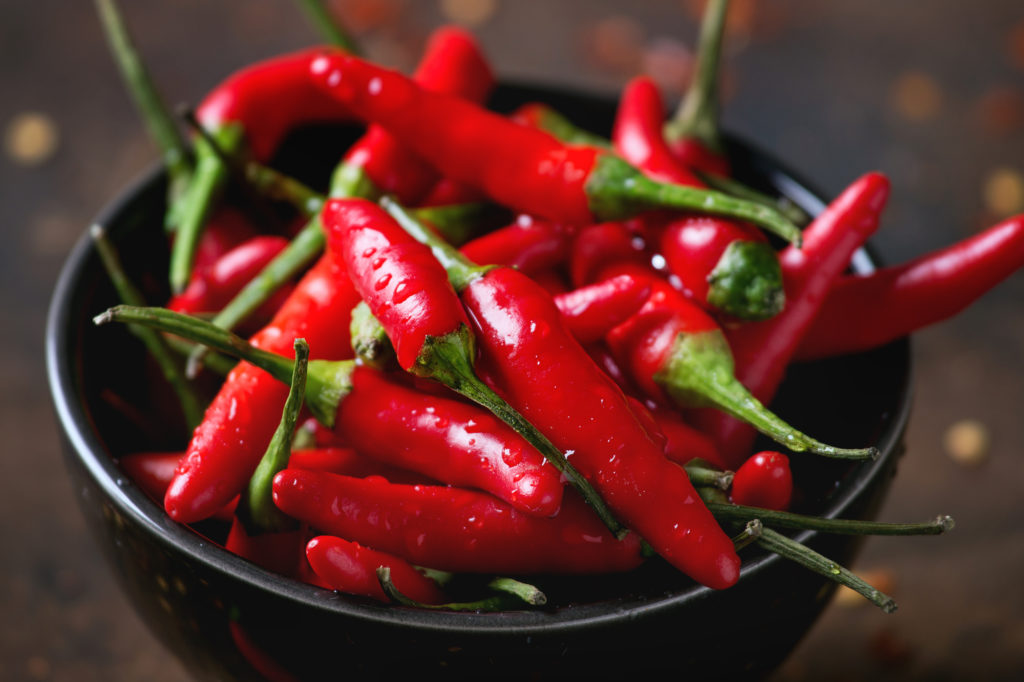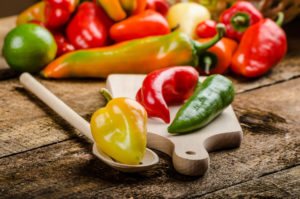
Believe me, you know the substance capsaicin (even if you think you don’t). And if you like spicy foods, odds are you know it very well. Capsaicin is a molecular compound found in chili peppers; turns out that capsaicin also contains a treasure trove of health benefits. Recent research has discovered all the different ways that capsaicin in chilis can help you on your healing journey with Breast Cancer as well.
What is Capsaicin?
Capsaicin is the main bioactive plant compound found in chili peppers. It is what gives peppers their “spice.” Native peoples all over the world have been using chili peppers for centuries. For example, Native Americans used to rub chilis on their gums to relieve mouth soreness and toothaches.
According to research, capsaicin communicates and binds with a cellular receptor in the body known as TRPV1, also called the “vanilloid receptor.” This receptor is actually signaled to “turn on” when it encounters a source of heat. It is this mechanism that will tell your body and brain at the cellular level that you have been burned or injured. Capsaicin triggers a very slight anti-inflammatory reaction through the TRPV1 receptor, which in turn starts a chain reaction of specific mechanisms that kicks off all the health benefits you are going to read about next.
Okay, enough with the science. Lets move on to the benefits that capsaicin can provide you on your Breast Cancer healing journey!
Capsaicin Benefits in General
Using the basic mechanism I just described above, capsaicin has been found to be a powerful antioxidant, anti-inflammatory, mood enhancer and antiviral. It can provide a boost to your circulatory system, pump up endorphins and anandamide levels (which can help with mood) and lower inflammation overall. Chili peppers also contain high levels of vitamins C and E as well as magnesium. They also contain carotenoids, phytonutrients which give peppers their bright red or yellow color. Carotenoids are known to be super powerful antioxidants as well.
Specifically, the capsaicin molecule found in chilis has also been found to help with the following conditions:
-circulation 
-diabetes symptoms
-other metabolic imbalances
-skin issues such as psoriasis
New Science about Capsicum and Cancer
Capsaicin’s connection to cancer healing has been known for a while actually. World Health Organization statistics show a connection between low rates of cancer deaths and countries such as Thailand and Mexico where chili peppers are consumed the most.
Recently, however, new research has come out that makes those connections even clearer.
For example, a 7-year-long study conducted just a few years ago at Harvard University (in coordination with the China Kadoorie Biobank study) and published in the British Medical Journal, took a look at half a million adult participants from all over that country to determine if spicy-food intake had an affect on longevity and common risk factors for disease.
They found that those who ate spicy foods once or twice a week had a 10% reduction in risk of death, compared to those who did not eat spicy foods at all. Those who ate spicy foods 3 to 7 days a week had a 14% reduction in death. They also found a significant reduction in certain kinds of disease, including heart disease, respiratory illness and cancer.
The Harvard-China Biobank study definitely saw a link between capsaicin consumption and lower cancer risk, although they did not speculate as to the cause of that link. Other research done in New Zealand and elsewhere has focused in on the exact mechanisms in capsaicin that work against cancer and for health. The key is apoptosis, or “programmed cancer cell death,” which capsaicin (like so many other powerful phytonutrients) can be the catalyst for.
Dr. David Popovich of Massey University’s School of Food and Nutrition found that apoptosis “encourages the turnover of cells—some with mutations.” This leads to the creation of new, healthy ones while the old, cancer-mutated ones get flushed out of the system.
How to Get Capsaicin in Your Diet
If you are a “chilihead” already, then you can probably skip this section. Odds are you probably include fresh jalapeños, serranos or those fire-breathing Thai chilis with every meal. If you have a more sensitive pallet or just don’t like the hotness that chili brings with it (but want to reap the benefits), you may want to consider a quality capsaicin supplement.
If you are willing to give it a try as a culinary as well as nutritional experiment, however, then here is a little encouragement. According to Dr. José de Jesús Ornelas-Paz, a researcher at the Research Center for Food and Development in Sonora, Mexico, the best way to get all the good stuff out of chilis and capsaicin in general is to consume it along with other foods.
 “Blending, cutting and cooking improve the release of [these compounds] from pepper tissue, increasing the amount available for absorption,” Dr. Paz told Time magazine in a recent interview. Other experts recommend consuming chili peppers along with a little fat. This is because capsaicin is a fat-soluble molecule. Combine it with a little olive oil in a sauce or sprinkle it on top of a meat dish, for example. This will help it absorb better in the body than when it is mixed with vegetables only or eaten alone.
“Blending, cutting and cooking improve the release of [these compounds] from pepper tissue, increasing the amount available for absorption,” Dr. Paz told Time magazine in a recent interview. Other experts recommend consuming chili peppers along with a little fat. This is because capsaicin is a fat-soluble molecule. Combine it with a little olive oil in a sauce or sprinkle it on top of a meat dish, for example. This will help it absorb better in the body than when it is mixed with vegetables only or eaten alone.
If you need some help getting started, why not try my Spicy Mexican Caulirice with Creamy Guacamole for a main dish or my Quick Organic Bean Dip for a snack on the go? You can replace the jalapenos or the prepared organic salsa with your favorite chili or use the recipes as they are.
Some Things to Consider Before You “Spice It Up”
Capsaicin is a proven natural healing substance. There are some things you should keep in mind when you are first starting out, however.
First of all, take it slow! It takes a while to build up a tolerance for spicy foods. Taking it slow also helps you to r evaluate how your particular body system reacts to chilis in particular. Keep in mind that peppers are “alkaloids.” This means that they belong to the nightshade vegetable family. Even though chilis typically have an anti-inflammatory effect on most people, those with nightshade-sensitivity may experience the opposite. Be aware if you experience joint pain or any other overly inflammatory response when eating chili peppers.
Finally, make sure you read all label ingredients if you choose to get your capsaicin in the form of a bottled salsa or hot sauce. Always opt for all-organic ingredients and watch the sugar and sodium content as well in pre-bottled items.
Give Capsaicin a Try For Your Health!
I continue to be amazed at the profound healing effects that I discover in the simplest of everyday foods. Chili peppers are easy to grow in your garden or in a container (especially in the summer since they like it HOT!). They are easy to find in the organic section of your local grocery store and are a delight to add here and there to any savory dish.
What’s more, there is literally a treasure trove of healing benefits inside of each one, including specific benefits that may help you on your Healthy Breast journey.
So bon Appetit and enjoy a capsaicin-filled chili pepper or two this summer for your health!
Dr. Veronique Desaulniers, better known as Dr. V, is the founder of The 7 Essentials System ™, a step-by-step guide that teaches you exactly how to prevent and heal Breast Cancer Naturally. To get your F.R.E.E. 7-day mini e-course, and to receive her weekly action steps and inspiring articles on the power of Natural Medicine, visit https://breastcancerconqueror.com.
I use to shake Cheyanne Pepper on most of my food especially veggies! Then I read somewhere that it was not good for you! Then I stopped using it! I gained weight and had more pain! Not saying it is a “cure-all” but, I am saying I will start using it like in the past!
Enjoy!!